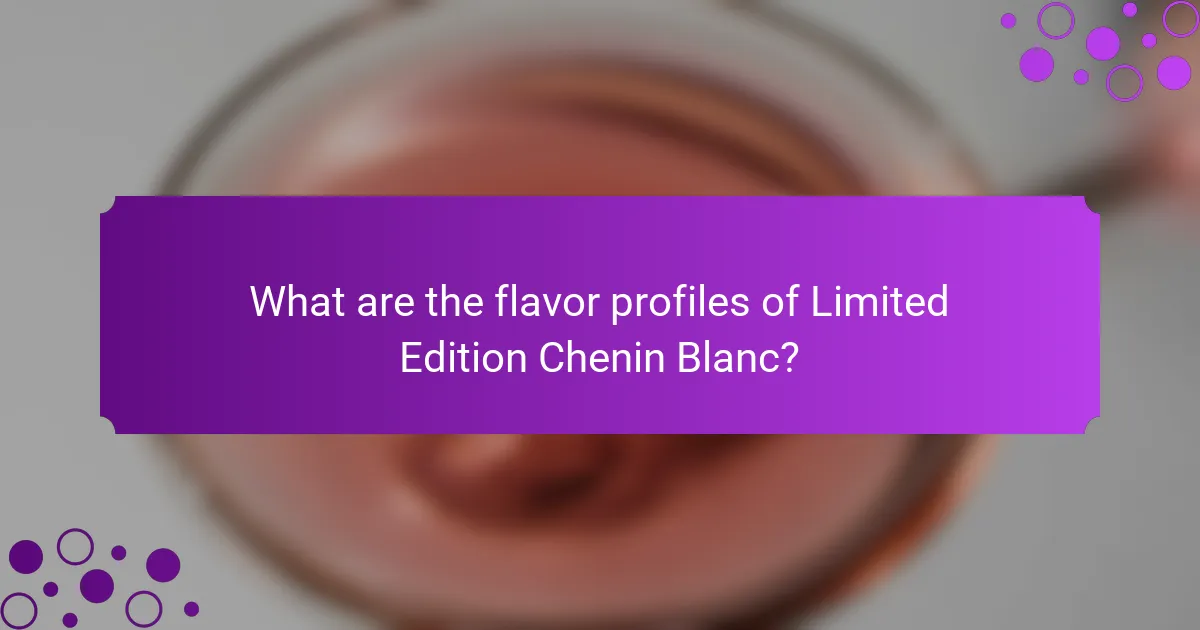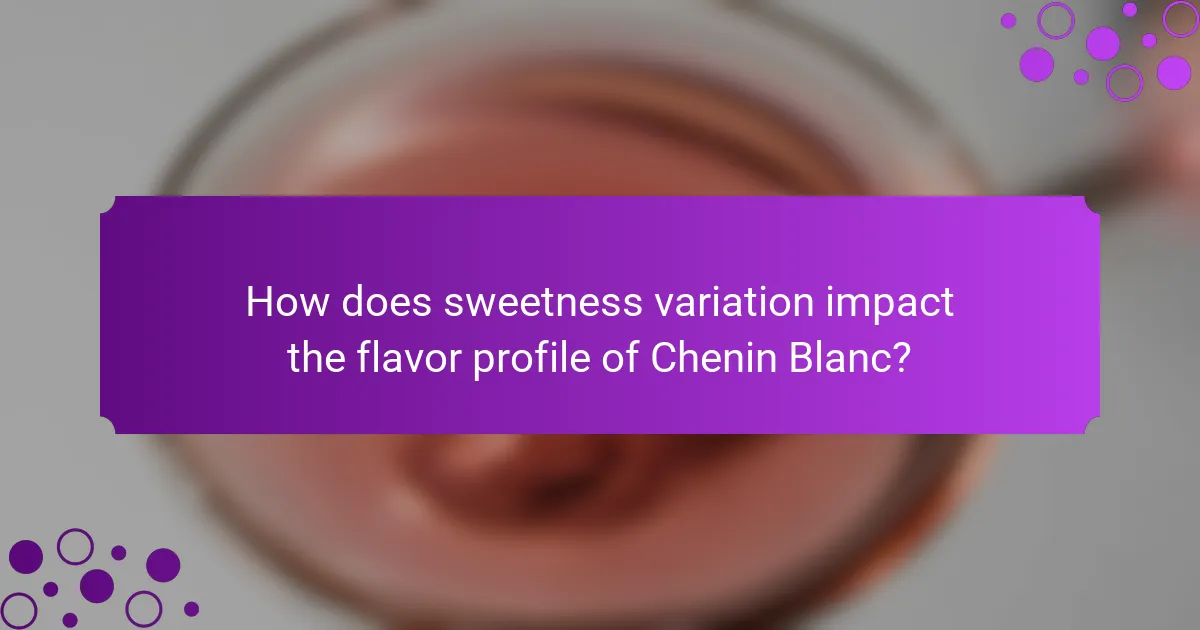
What are the flavor profiles of Limited Edition Chenin Blanc?
Limited Edition Chenin Blanc typically exhibits a range of flavor profiles. These include notes of green apple, pear, and citrus. Floral aromas such as honeysuckle and jasmine are also common. Some variations may present tropical fruit flavors like pineapple and mango. The wine can display a refreshing acidity balanced with sweetness. Oak aging may add complexity, introducing vanilla and butter nuances. Overall, the flavor profiles can vary significantly based on the region and winemaking techniques.
How do the unique characteristics of Chenin Blanc influence its flavor?
The unique characteristics of Chenin Blanc significantly influence its flavor profile. Chenin Blanc is known for its high acidity and versatility. This acidity contributes to a crisp and refreshing taste. The grape can express a range of flavors, from green apple and pear to honey and floral notes. These flavors vary based on the ripeness of the grapes and the region where they are grown.
Chenin Blanc can be made in various styles, including dry, off-dry, and sweet. Each style showcases different flavor dimensions. For example, dry Chenin Blanc typically has more mineral and citrus notes. In contrast, sweeter versions exhibit richer flavors like peach and apricot.
The aging process also affects flavor. Chenin Blanc can develop complex characteristics through barrel aging. This can introduce creamy textures and additional layers of flavor, such as vanilla and spice.
Overall, the unique attributes of Chenin Blanc shape its diverse flavor profile, making it suitable for various food pairings.
What are the primary flavor notes found in Chenin Blanc?
Chenin Blanc primarily exhibits flavor notes of apple, pear, and citrus. These flavors contribute to its fresh and vibrant profile. Additionally, it may present hints of stone fruit, such as peach or apricot. Floral notes, like honeysuckle, are also common in some expressions. The wine can display a range of sweetness levels, from dry to sweet, which influences its flavor complexity. In cooler climates, Chenin Blanc tends to have more pronounced acidity, enhancing its crispness. The diversity in flavor notes makes Chenin Blanc versatile for pairing with various foods.
How does the terroir affect the flavor of Chenin Blanc?
Terroir significantly influences the flavor of Chenin Blanc. Terroir encompasses soil, climate, and topography. These factors affect grape growth and ripening. Different soils impart unique mineral characteristics. For example, clay soils can enhance richness. Sandy soils often lead to lighter, crisper wines. Climate plays a crucial role in acidity and sugar levels. Cooler climates typically produce higher acidity and more floral notes. Warmer regions may yield riper, fruitier flavors. Topography affects sun exposure and drainage. These variations contribute to a diverse range of flavor profiles in Chenin Blanc. Studies show that terroir-driven differences can be profound, impacting wine quality and style.
What makes Limited Edition Chenin Blanc distinct from regular offerings?
Limited Edition Chenin Blanc is distinct from regular offerings primarily due to its unique production methods. These methods often involve handpicking grapes from select vineyards, ensuring higher quality. Limited editions may also undergo extended aging in oak barrels, enhancing complexity and depth of flavor. The result is a more refined taste profile, often showcasing richer fruit notes and nuanced acidity. Additionally, limited releases typically reflect specific terroirs, contributing to their exclusivity. This focus on craftsmanship and terroir sets them apart, making them sought after by collectors and enthusiasts.
How are limited editions produced differently?
Limited editions are produced differently through exclusive sourcing and controlled quantities. These editions often utilize specific grapes or unique vineyard locations. The winemaking process may include distinct fermentation methods or aging techniques. Limited editions typically have shorter production runs, enhancing their rarity. This approach creates unique flavor profiles that stand out. For example, a limited edition Chenin Blanc may showcase specific terroir characteristics. The exclusivity often leads to higher market value and collector interest. Overall, the production method emphasizes uniqueness and quality over volume.
What attributes contribute to the exclusivity of Limited Edition Chenin Blanc?
Limited Edition Chenin Blanc is exclusive due to its unique attributes. These attributes include limited production quantities, which create scarcity. The use of specific terroirs contributes distinct flavor profiles. Unique aging processes, such as oak barrel maturation, enhance complexity. Selective grape sourcing from high-quality vineyards ensures superior quality. Special labeling and packaging distinguish these wines in the market. Limited releases often feature unique blends or varietals not commonly available. These factors combined elevate the perceived value and desirability of Limited Edition Chenin Blanc.

How does sweetness variation impact the flavor profile of Chenin Blanc?
Sweetness variation significantly impacts the flavor profile of Chenin Blanc. Different levels of sweetness create distinct taste experiences. Dry Chenin Blanc typically exhibits crisp acidity and notes of green apple and citrus. Off-dry versions introduce honeyed flavors and stone fruits like peach. Sweet Chenin Blanc, often classified as dessert wine, showcases rich flavors of apricot, pineapple, and caramel. The balance between sweetness and acidity is crucial. Higher sweetness can soften acidity, resulting in a smoother mouthfeel. This interplay influences food pairing possibilities, enhancing versatility. Studies show that sweetness levels can alter perceived complexity and depth in the wine’s flavor.
What are the different sweetness levels in Chenin Blanc?
Chenin Blanc has several sweetness levels, including dry, off-dry, medium sweet, and sweet. Dry Chenin Blanc contains less than 1 gram of residual sugar per liter. Off-dry versions have between 1 to 10 grams of residual sugar. Medium sweet Chenin Blanc typically ranges from 10 to 30 grams of residual sugar. Sweet Chenin Blanc can have over 30 grams of residual sugar. These variations allow Chenin Blanc to pair with a wide range of foods, enhancing its versatility in different culinary contexts.
How do dry, off-dry, and sweet styles differ in flavor?
Dry styles have little to no residual sugar, resulting in crisp and refreshing flavors. These wines often exhibit high acidity and fruit notes like green apple or lemon. Off-dry styles contain a small amount of residual sugar, leading to a balance of sweetness and acidity. This style often features flavors of ripe stone fruits, such as peach or apricot, alongside a refreshing finish. Sweet styles have higher residual sugar, creating rich and luscious flavors. These wines can showcase honeyed notes, tropical fruits, and a smooth mouthfeel. The distinct sugar levels in each style influence the overall taste experience significantly.
What factors influence sweetness levels in Chenin Blanc production?
The sweetness levels in Chenin Blanc production are influenced by several key factors. These include the ripeness of the grapes at harvest, the fermentation process, and the winemaking techniques employed. Grapes that are allowed to fully ripen develop higher sugar concentrations. During fermentation, yeast converts sugars into alcohol, impacting the final sweetness. If fermentation is stopped early, residual sugars remain, resulting in sweeter wines. Additionally, techniques like late harvesting or noble rot can enhance sweetness. These methods are commonly used in regions known for producing dessert-style Chenin Blanc.
Why is sweetness an important attribute in evaluating Chenin Blanc?
Sweetness is an important attribute in evaluating Chenin Blanc because it directly influences the wine’s flavor profile and balance. Chenin Blanc can range from dry to sweet, affecting its overall taste experience. The level of sweetness impacts the perception of acidity, making the wine feel more or less refreshing. Additionally, sweetness enhances the wine’s fruitiness, contributing to its complexity. For example, sweeter styles often showcase notes of honey, apricot, and tropical fruits, which are appealing to many consumers. Furthermore, the sweetness level can determine food pairing options, as sweeter wines complement spicy or rich dishes effectively. Understanding sweetness helps tasters appreciate the versatility and character of Chenin Blanc.
How does sweetness affect overall taste perception?
Sweetness significantly influences overall taste perception. It interacts with other taste modalities, such as sourness and bitterness. Sweetness can enhance the overall flavor profile of a beverage or food. It often masks undesirable flavors, making products more palatable. Research shows that sweetness is one of the primary taste sensations, detected by taste buds on the tongue. The perception of sweetness can alter the balance of flavors, creating a more harmonious experience. For example, in wines like Chenin Blanc, varying levels of sweetness can affect the wine’s complexity and food pairing compatibility. Studies indicate that sweeter wines often complement rich or spicy dishes better than dry wines.
What role does sweetness play in food pairing with Chenin Blanc?
Sweetness in Chenin Blanc enhances its compatibility with various foods. It balances acidity, making the wine more refreshing alongside rich dishes. Sweetness also complements spicy foods, softening heat and enhancing flavor profiles. Additionally, sweeter Chenin Blancs pair well with desserts, creating a harmonious contrast. The wine’s fruitiness is accentuated when paired with dishes featuring similar flavor notes. Research indicates that sweetness can elevate the overall dining experience, making it a key factor in food pairing.

What food pairings are best suited for Limited Edition Chenin Blanc?
Limited Edition Chenin Blanc pairs well with seafood, particularly shellfish and grilled fish. Its acidity complements the brininess of oysters and the richness of lobster. Poultry dishes, especially those with citrus or creamy sauces, also match well. The wine’s fruity notes enhance the flavors of roasted chicken and duck. Vegetarian options like creamy risottos or salads with goat cheese are ideal pairings. Spicy Asian dishes, such as Thai curry, can balance the wine’s sweetness. These pairings highlight the versatility of Limited Edition Chenin Blanc in various culinary contexts.
How does the flavor profile of Chenin Blanc influence food compatibility?
The flavor profile of Chenin Blanc significantly influences its food compatibility. Chenin Blanc typically exhibits high acidity, which enhances its pairing with rich and fatty foods. The wine’s fruit-forward characteristics, such as apple, pear, and honey, complement a variety of dishes. Its versatility allows it to pair well with seafood, poultry, and spicy cuisines. The sweetness levels in Chenin Blanc can range from dry to sweet, further expanding its compatibility with diverse foods. For instance, sweeter variations match well with desserts and spicy dishes, balancing heat and sweetness. Studies have shown that wines with high acidity and fruitiness enhance the overall dining experience by elevating flavors in food.
What types of dishes complement the flavors of Chenin Blanc?
Dishes that complement the flavors of Chenin Blanc include seafood, poultry, and vegetarian options. Seafood dishes like grilled shrimp or scallops enhance the wine’s acidity. Poultry dishes, such as roasted chicken or duck, pair well due to their rich flavors. Vegetarian options like creamy risotto or mushroom dishes also match the wine’s profile. Additionally, spicy Asian cuisine, particularly Thai or Indian dishes, can highlight the wine’s fruitiness. Cheese plates featuring goat cheese or brie further elevate the tasting experience. Each of these dishes balances Chenin Blanc’s sweetness and acidity, creating a harmonious pairing.
How can the sweetness level of Chenin Blanc guide food pairing choices?
The sweetness level of Chenin Blanc significantly influences food pairing choices. Sweeter Chenin Blancs complement spicy dishes, as the sugar balances heat. For example, a late-harvest Chenin Blanc pairs well with Thai curry. Off-dry versions enhance the flavors of roasted vegetables and poultry. Dry Chenin Blanc, with its acidity, matches well with seafood and salads. The acidity in dry styles cuts through rich, creamy sauces. Thus, the sweetness level serves as a guide for pairing with various cuisines.
What are some tips for pairing Limited Edition Chenin Blanc with meals?
Pair Limited Edition Chenin Blanc with light and fresh dishes. Seafood, especially shellfish, complements its acidity. Pair it with salads featuring citrus or vinaigrette for balance. Spicy Asian cuisine works well due to its sweetness. Rich, creamy dishes also match nicely, enhancing the wine’s texture. Consider cheese plates with goat cheese or brie for a delightful experience. Grilled vegetables can highlight the wine’s versatility. These pairings enhance the overall dining experience with Chenin Blanc.
How can one enhance the tasting experience with food pairings?
Enhancing the tasting experience with food pairings involves selecting complementary flavors. Pairing Chenin Blanc with dishes that highlight its acidity can elevate the overall flavor. For instance, seafood and citrus-based sauces work well with this wine. The wine’s natural sweetness complements spicy foods, balancing heat with sweetness. Rich, creamy dishes also benefit from the wine’s acidity, creating a harmonious blend. Research indicates that well-chosen pairings can enhance perception of aromas and flavors. This is supported by studies showing that complementary flavors create a more enjoyable tasting experience.
What common mistakes should be avoided when pairing Chenin Blanc with food?
Common mistakes to avoid when pairing Chenin Blanc with food include overlooking its acidity. Chenin Blanc often has high acidity, which can enhance dishes but clash with overly rich foods. Another mistake is ignoring sweetness levels. Pairing a sweet Chenin Blanc with spicy dishes can amplify heat, leading to an unbalanced experience. Additionally, failing to match the wine’s body with the food can result in either overpowering or underwhelming flavors. For example, a full-bodied Chenin Blanc pairs poorly with light salads. Finally, not considering the wine’s age can lead to mismatches. Older Chenin Blancs may have more complex flavors that require equally sophisticated food pairings.
The main entity of the article is Limited Edition Chenin Blanc, a versatile wine known for its diverse flavor profiles influenced by factors such as terroir and production methods. The article explores the primary flavor notes, including green apple, pear, and floral aromas, while highlighting how sweetness variations—from dry to sweet—impact the tasting experience and food pairing possibilities. It also discusses the unique characteristics that differentiate Limited Edition offerings from regular Chenin Blanc, emphasizing their exclusive production methods and the role of sweetness in enhancing compatibility with various cuisines. Overall, the article provides a comprehensive overview of the flavor profiles, sweetness levels, and ideal food pairings for Limited Edition Chenin Blanc.